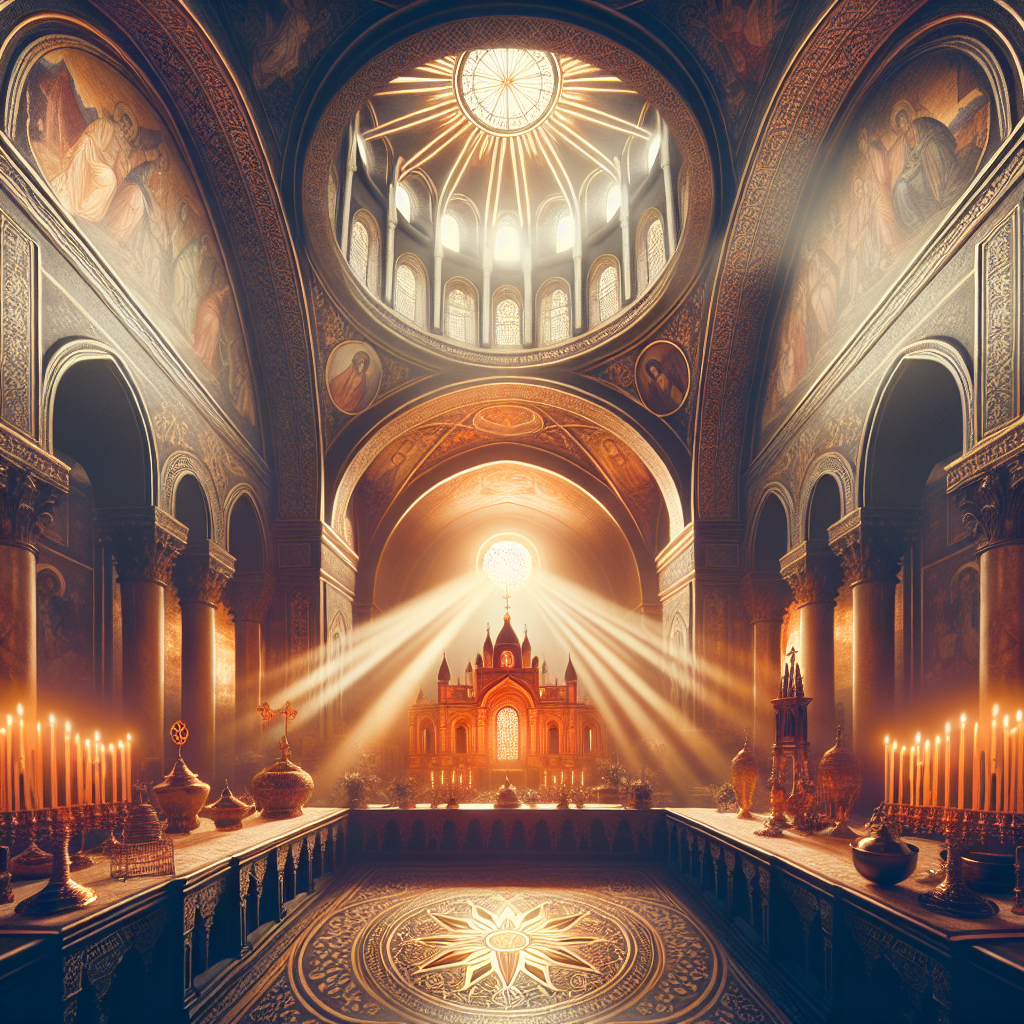Spiritual Devotional about Sacred Art
Sacred Art: The Divine Canvas of Faith and Inspiration
Greetings, beloved family in Christ!
Today, let’s embark on an enlightening journey into the realm of Sacred Art—a magnificent testimony to God’s boundless glory and an inspiring wellspring for our spiritual lives.
Sacred Art has graced our churches, homes, and hearts for centuries, serving as a vivid expression of divine truths and heavenly beauty. More than mere decoration, these sacred images are visual sermons that encapsulate the essence of our faith, guiding us deeper into our relationship with God.
Biblical Roots of Sacred Art
The Bible itself affirms the significance of using art to convey God’s majesty and truth. In Exodus 31:1-5, we read about Bezalel, an artist filled with the Spirit of God, who was chosen to craft the intricate designs of the Tabernacle:
"Then the Lord said to Moses, ‘See, I have chosen Bezalel son of Uri, the son of Hur, of the tribe of Judah, and I have filled him with the Spirit of God, with wisdom, with understanding, with knowledge and with all kinds of skills—to make artistic designs for work in gold, silver and bronze, to cut and set stones, to work in wood, and to engage in all kinds of crafts.’"
Here we see that God Himself values artistic expression. Each stroke of the brush, each chisel in stone, and each mosaic tile reflects a unique aspect of His magnificent splendor. Bezalel’s divinely inspired craftsmanship wasn’t just for ornamentation; it was a sacred act of worship.
A Canvas for Reflection and Worship
When you gaze at sacred art—be it a Renaissance painting, a stained-glass window, or a contemporary mural—you’re invited into an intimate dialogue with the divine. The beauty before your eyes gently pulls you into meditation, prayer, and reflection.
Consider the iconic image of Jesus the Good Shepherd. This portrayal instantly evokes the comforting words of Psalm 23:1, "The Lord is my shepherd; I shall not want." Each detail in the composition—the serene pastures, the guiding staff—serves as a reminder of God’s constant care and guidance in our lives.
A Celebration of Diverse Expressions
One of the most beautiful aspects of Sacred Art is its diversity. From the sublime iconography of the Orthodox tradition to the dynamic and colorful retablos of Latin America, each cultural expression adds a unique voice to the symphony of praise to our Creator. Ephesians 2:10 beautifully encapsulates this:
"For we are God’s handiwork, created in Christ Jesus to do good works, which God prepared in advance for us to do."
As God’s handiwork, we reflect His creativity in countless ways. Our diverse expressions of Sacred Art become a kaleidoscope of worship, where every style and medium contributes to the richness of our shared faith.
Inspire and Be Inspired
I encourage you, dear reader, to delve deeper into the world of Sacred Art. Visit local galleries, flip through art history books, or simply observe the artwork in your place of worship with fresh eyes. Allow these sacred images to stir your heart, speak to your soul, and draw you closer to God.
Moreover, don’t hesitate to engage with your own artistic abilities. Whether you’re an experienced artist or a novice with a heart full of passion, let your creativity be an outpouring of worship. Psalm 96:1-2 invites us to:
"Sing to the Lord a new song; sing to the Lord, all the earth. Sing to the Lord, praise his name; proclaim his salvation day after day."
So, why not paint a new canvas, sketch a new design, or sing a new song? Your gift of Sacred Art can become a cherished offering that inspires and uplifts others.
As we celebrate and create Sacred Art, we join a timeless tradition of proclaiming God’s glory. Let us embrace this beautiful form of worship with joy and gratitude, ever inspired to reflect the divine love that binds us all.
May you be blessed and inspired as you explore the rich world of Sacred Art!
In His Grace,
[Your Name]
Explore and dig up answers yourself with our BGodInspired Bible Tools! Be careful – each interaction is like a new treasure hunt… you can get lost for hours 🙂
Q&A about Sacred Art
Certainly! Here’s a Q&A based on the topic of Sacred Art:
Q: What is Sacred Art?
A: Sacred Art is a genre of artistic creations that are driven by religious or spiritual inspiration. This form of art often depicts the beliefs, practices, and cultural narratives of a particular faith. These works can be found in various mediums such as paintings, sculptures, stained glass, and manuscripts.
Q: Which religions have a rich tradition of Sacred Art?
A: Many of the world’s major religions have rich traditions of Sacred Art, including Christianity, Islam, Hinduism, Buddhism, and Judaism. Each tradition has its own unique styles and symbolic languages that reflect its doctrines and spiritual aesthetics.
Q: Can you give an example of Sacred Art in Christianity?
A: One prominent example of Christian Sacred Art is Michelangelo’s frescoes in the Sistine Chapel, particularly "The Creation of Adam." Other examples include icons in the Eastern Orthodox Church, stained glass windows found in Gothic cathedrals like Notre-Dame, and illuminated manuscripts such as the Book of Kells.
Q: What is the significance of Sacred Art in Hinduism?
A: In Hinduism, Sacred Art often takes the form of intricate sculptures and temple architecture. Deities are depicted in vibrant, symbolic imagery that illustrates various aspects of their divinity. The murals and carvings on temples like those at Khajuraho and the paintings of deities such as Shiva, Vishnu, and Durga are prime examples.
Q: What role does calligraphy play in Islamic Sacred Art?
A: In Islamic Sacred Art, calligraphy is profoundly significant due to the prohibition against depicting human and animal forms in religious contexts. Instead, artists focus on beautiful, intricate Arabic script to write verses from the Quran and other religious texts. This form of art appears in manuscripts, on ceramics, and as architectural ornamentation.
Q: How does Buddhist art represent spiritual concepts?
A: Buddhist art is characterized by the depiction of Buddhas, bodhisattvas, and other deities. Symbolic representations like mandalas are used as tools for meditation and spiritual teaching. The intricate carvings and statues found in places like the Borobudur Temple or the murals in Tibetan monasteries are well-known examples.
Q: Why is the preservation of Sacred Art important?
A: Preserving Sacred Art is vital for maintaining cultural heritage and understanding the spiritual and historical contexts of various religions. These works are critical for academic study, spiritual reflection, and fostering mutual respect among different faith communities. They serve as tangible links to the past and provide insight into the evolution of religious thought and artistic expression.
Q: How has the modern world influenced Sacred Art?
A: In the modern world, Sacred Art continues to evolve, often incorporating contemporary techniques and mediums while still retaining traditional themes and motifs. Artists today might use digital media, experimental forms, or globalized styles to express their spirituality, addressing current societal issues while remaining rooted in their religious traditions.
Q: Can Sacred Art be appreciated by those outside of the faith it represents?
A: Absolutely. While Sacred Art has a specific spiritual significance for adherents, it can also be appreciated by people outside the faith for its aesthetic beauty, technical mastery, and cultural insights. It often serves as a bridge for intercultural and interfaith dialogue, fostering greater understanding and empathy.
If you have any other questions or need further information, feel free to ask!


